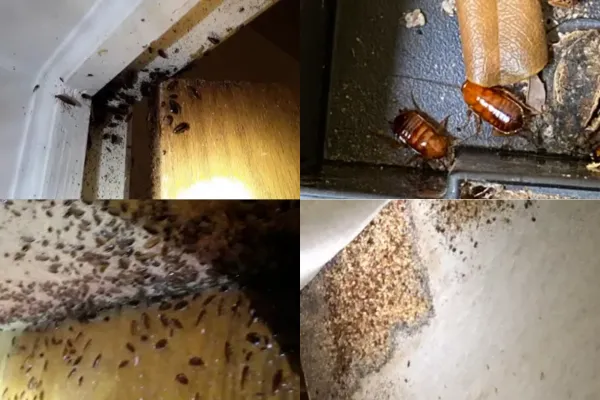
BLOGS
BLOG

Top Signs Your Roach Problem Is Worse Than You Think
Cockroaches are every homeowner’s nightmare. They’re fast, resilient, and experts at hiding in the smallest cracks and crevices. But here’s the unsettling truth: if you’ve seen even one roach scurry across your kitchen floor at night, there’s a high chance more are lurking just out of sight. Roaches are social pests, and when you spot one, it’s usually a sign of a much bigger problem.
While it’s tempting to think a few roaches aren’t a big deal, ignoring the issue can quickly turn a nuisance into a full-blown infestation. Severe infestations don’t just create an unsanitary environment—they pose real health risks and can damage your home.
So how do you know if your roach problem is worse than you think? Let’s dive into the warning signs every homeowner should watch out for.
1. Roaches During the Day
Cockroaches are nocturnal by nature. If you see them crawling around during the daytime, it’s usually because their hiding places are overcrowded. This means the infestation has grown so large that some roaches are being forced out into the open. Daytime sightings are one of the clearest red flags that your problem has escalated beyond a minor issue.
2. Egg Casings Around Your Home
Cockroaches reproduce at an alarming rate. Female roaches produce egg casings called oothecae, which can hold anywhere from 10 to 50 eggs, depending on the species. If you start finding these small, capsule-shaped casings in your pantry, behind appliances, or along baseboards, it’s a definite sign that roaches aren’t just visiting—they’re breeding.
And remember: if you find empty egg casings, the eggs have already hatched, meaning dozens more roaches are now crawling around your home.
3. Strong, Musty Odor
Severe roach infestations often come with a distinctive, unpleasant smell. Roaches release pheromones that help them communicate with each other, and as their numbers grow, so does the odor. Many homeowners describe it as oily, musty, or even sweet. If your kitchen, bathroom, or storage areas start to develop this smell, it’s a serious indicator of a large infestation.
4. Droppings That Look Like Coffee Grounds
Cockroach droppings are small, dark, and resemble coffee grounds or black pepper. Larger roaches, like American cockroaches, leave behind cylindrical droppings, while smaller ones leave fine specks. If you find droppings in cabinets, under sinks, behind appliances, or near food storage, your roaches are not only present but actively feeding and moving around your home.
Consistent droppings in multiple areas are a strong sign that the population is growing—and fast.
5. Shed Skins
As roaches grow, they shed their exoskeletons. A single roach can shed its skin up to eight times before reaching adulthood. If you start spotting these pale, flaky skins near dark corners, basements, or behind appliances, it’s a sign that roaches are maturing and reproducing right under your nose.
6. Allergies or Asthma Worsening Indoors
Cockroach infestations aren’t just disgusting—they’re dangerous to your health. Roach droppings, saliva, and shed body parts are all known allergens that can trigger asthma attacks and allergic reactions, especially in children and sensitive individuals.
If you or your family members suddenly start experiencing unexplained allergy symptoms—sneezing, coughing, watery eyes, or worsening asthma—your roach problem may be contributing more than you realize.
7. Damage to Food and Packaging
Roaches aren’t picky eaters. They’ll chew through cardboard, thin plastic, and even glue to access food sources. If you notice gnaw marks on packages or crumbs scattered in unusual places, it’s likely roaches are raiding your pantry at night.
Worse, they contaminate everything they touch with bacteria, making your food unsafe to eat.
8. Nests in Warm, Hidden Spaces
Roaches love warmth, moisture, and darkness. Common nesting spots include behind refrigerators, under sinks, inside pantries, and in cracks along walls. If you start uncovering clusters of roaches when moving appliances or cleaning out storage areas, it’s a sign that they’ve established multiple nests in your home.
Why Severe Roach Infestations Are Dangerous
Severe roach infestations aren’t just unsettling—they come with serious risks:
Health Risks: Roaches carry bacteria like Salmonella and E. coli that can cause food poisoning, diarrhea, and other illnesses.
Allergies & Asthma: Their droppings and shed skins are major indoor allergens.
Rapid Reproduction: A single pair of roaches can produce thousands of offspring in just a year.
Property Damage: They can chew through packaging, fabrics, and even electrical wiring in some cases.
When left untreated, roach infestations don’t just spread quickly—they become exponentially harder to eliminate.
DIY Fixes Aren’t Enough
Many homeowners try to tackle roach problems with sprays or traps from the store. While these may kill a few roaches, they won’t reach the nests or eliminate eggs. Roaches are highly adaptable and can develop resistance to common pesticides.
If you’re seeing multiple signs of a severe infestation, it’s time to stop relying on temporary fixes.
How Valley Wide Pest Control Can Help
At Valley Wide Pest Control, we understand how unsettling and dangerous roach infestations can be. That’s why we use proven, professional methods to eliminate not just the visible roaches, but the entire infestation at its source.
Here’s how we help homeowners:
Thorough Inspections: We identify all nesting areas and entry points.
Targeted Treatments: Using safe and effective methods designed to eliminate roaches at every stage of life.
Follow-Up Visits: Ensuring the infestation is fully eradicated and doesn’t return.
Preventive Solutions: Sealing entry points and advising on long-term prevention to keep your home roach-free.
With over 40 years of experience, Valley Wide Pest Control has built a reputation for helping Central Valley homeowners take back their homes from pests—safely and effectively.
Final Thoughts
Roaches aren’t just a nuisance; they’re a warning sign that your home is under threat. If you’ve noticed droppings, egg casings, musty odors, or even daytime sightings, your roach problem is likely much worse than you think.
Don’t wait until the infestation spirals out of control. With professional help from Valley Wide Pest Control, you can protect your family, your home, and your peace of mind.
Experiencing roach problems? Call Valley Wide Pest Control today and let us help you take back your home.
© 2024 Valley Wide Pest Control. All rights reserved.

